WHAT'S NEW
ACROSS THE WORLD
Select date in side bar to go to a What's
New of previous issues
| What's New ©by
Laif DeMason
The summer is now upon us and the
impact of the economic slowdown is more apparent, especially for the
tropical fish hobby. While some fish shop retailers report an increase
in sales of common fish over the same time last year, sales of
the more expensive specialty items (like most cichlids) have decreased.
Certainly the collectors, breeders, and exporters of cichlids have
changed their approach to their inventories. Short term sales and
offering unique items have helped to spur more purchasing somewhat.
However, hobbyists will only buy what they can afford. Thus, some
producers say they cannot continue in the future.
Here’s “what’s new” on the cichlid
scene:
|
Lake Tanganyika
Although collecting and export from most African countries has
decreased, interest in Tanganyika cichlids has increased somewhat in
the USA. Some exporters around the lake have temporarily closed shop
due to weak prices and lack of sales. Other exporters have come out of
retirement to meet the demand from the USA. Also of note, exporters are
doing their best to bring unique and new fish to the marketplace.
|
what's
new: Lake Tanganyika
|

Exported from Burundi recently is a
somewhat rarer and certainly lesser known species of Limnochromis. Perhaps this new fish
is L. abeelei and is
currently collected in low numbers.
|

Some newer items are collected in Congo
close to the Burundi border. As of late, some goby cichlids have
appeared for sale from Makobola, Congo. Here Spathodus marlieri from this
location has been imported.
|

Another goby cichlid also collected from
Makobola, Congo, is the northern species of Eretmodus. This variety has an
overall tawny yellow color and bluish markings on its throat.
|
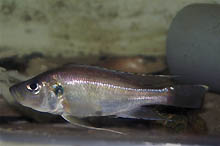
A super rare find from Burundi is
the Greenwoodochromis bellcrossi.
Only a few individuals have be collected as of this writing and none
exported to date. Let us hope more are found and can be exported
to avid fans! Photo courtesy of M. Schreyen.
|
Lake Malawi
Demand for wild-caught cichlids from Lake Malawi seems to be
at an all time low. Due to ever increasing freight and styrofoam box
charges, the past great bargains and prices are now long gone. To
counter the low demand, collectors have stepped up the search for new
items as well as hard to find items. There has been some success in
actually collecting wild Nimbochromis
fuscoteaniatus and Chilotilapia
rhoadesi as well as other items.

Several of the smaller mbuna varieties
are popular now. Recently a Pseudotropheus
minutus-like cichlid has been collected and imported from
different localities. Pictured here, the variant from Manda,
Tanzania. |

The “elongatus” types have also been
collected for a little something different. Sold as Ps. elongatus Kanchedza (Malawi),
this cichlid is reportedly less aggressive than other types of the
elongatus group. Photo by A. Konings. |

In the early days of collecting Malawi
cichlids, several of the exported haplochromines like Nimbochromis fuscotaeniatus, were
actually caught in Lake Malombe to the south. Now they are sporadically
caught in Lake Malawi. Photo by A. Konings. |

Collecting cichlids along the Mozambique
coast is becoming more difficult for various reasons. All the more
important to keep stable breeding colonies of items like the “blue
dwarf auratus” from Mozambique, now called Melanochromis wochepa. Photo by A.
Konings. |
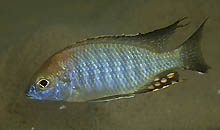
Long-forgotten in the past, Lethrinops varieties are now
popular with specialty breeders. Species similar to Lethrinops auritus have been found
at several locations around the Lake. Photo by A. Konings. |
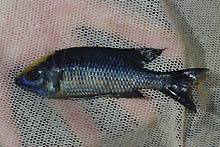
Rarely caught for export, Copadichromis sp. ‘goldcrest
mloto’ can be obtained from specialty breeders while they last! |
Lake Victoria
Exports of Lake Victoria cichlids from the surrounding
countries are non-existent. Victoria cichlid fans must still rely on
the bred fish from original stocks collected over a decade ago.
Occasionally new albino forms or offspring of small breeder colonies
will appear for sale.
|
what's
new: Lake Victoria
|

Another albino form of a well-known
Victorian basin cichlid appeared in the hobby recently. Here is a
beautiful albino ‘Haplochromis’
sp. all red, originally from the Lake Kyoga area. |

Popular in the past, but rarely seen
now, ‘Haplochomis’ sp. red
parvidens is originally from Lake Nawampasa, Uganda, and is still being
bred in small numbers. |
Neotropics
The availability of cichlids from the New World remains
strong. Spotty shortages are reported from Brazil due to local
government bans on certain species. Other exporting countries are
making discounts to reduce inventories and attract new sales. Specialty
breeders of unique items have even more to offer!

Imported from the Brazilian Amazon, this
is a rarely seen species of freshwater angelfish, Pterophyllum dumerili. It is also
known as the “long nose” angelfish. Photo by A. Konings. |
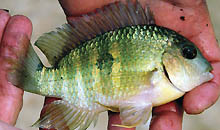
Originally from Bolivia, Aequidens viridis is an unusual
cichlid found on a collecting trip by hobbyists and brought back to be
bred. Photo by S. Jack. |
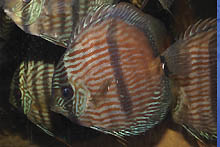
A beautiful wild caught heckel discus
from the Rio Abacaxi, Brazil, southeast of Manaus. These discus are
infrequently collected according to the river conditions. Photo by S.
Jack.
|
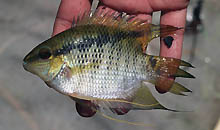
Collected in Suriname, Mesonauta guyanae can be very
aggressive compared to any of the other M. festivum types. Interested
parties should take note! Photo by S. Jack.
|
Select date in side bar to go a What's
New of previous issues
|















